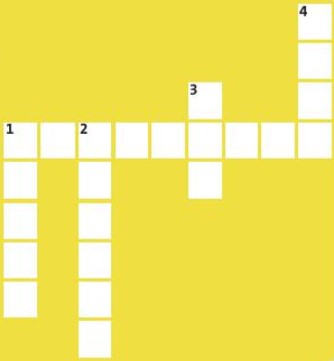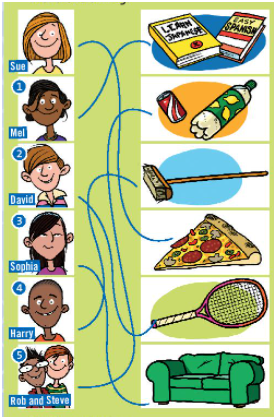Bài 1
1. GUESS THE FOOD. Work in pairs. Look at the words in the box. One student chooses a word and makes a sentence about it. The other student listens and guesses the food.
(ĐOÁN TÊN MÓN ĂN. Làm việc theo cặp. Nhìn vào các từ trong khung Một học sinh chọn một từ và đặt một câu về từ đó. Học sinh còn lại lắng nghe và đoán tên món ăn.)
|
burger pasta raisins meat juice sweets rice vegetables nuts crisps cheese pear olives tuna |
It’s got bread and meat. It’s unhealthy.
(Nó có bành mì và thịt. Nó không lành mạnh lắm.)
Burger?
(Bánh burger à?)

- burger (n): bánh mì kẹp thịt
- pasta (n): mì ống
- raisins (n): nho khô
- meat (n): thịt
- juice (n): nước ép trái cây
- sweets (n): kẹo
- rice (n): gạo/ cơm
- vegetables (n): rau củ
- nuts (n): các loại hạt
- crisps (n): khoai tây chiên
- cheese (n): phô mai
- pear (n): lê
- olives (n): quả ô liu
- tuna (n): cá ngừ

1.
A: It looks like noodles but it is bigger than noodles.
(Trông giống như sợi mì nhưng nó to hơn sợi mì.)
B: Pasta? (Mỳ ống à?)
2.
A: It’s the dried grapes.
(Đó là nho được làm khô.)
B: Raisin? (Nho khô?)
3.
A: It’s a liquid and it’s really good for our health?
(Nó là một chất lỏng và nó thực sự tốt cho sức khỏe của chúng ta?)
B: Juice? (Nước trái cây à?)
4.
A: Children like them. They can cause toothache.
(Trẻ em thích chúng. Chúng có thể gây đau răng.)
B: Sweets? (Kẹo à?)
5.
A: Vietnamese people eat it every day?
(Người Việt Nam ăn nó hàng ngày.)
B: Rice? (Cơm à?)
6.
A: It’s green and it’s really good for our health?
(Nó có màu xanh và nó thực sự tốt cho sức khỏe của chúng ta?)
B: Vegetables? (Rau à?)
7.
A: It’s hard and it’s inside the fruits.
(Nó cứng và nó ở bên trong quả.)
B: Nuts? (Hạt à?)
8.
A: They are made of potatoes.
(Chúng được làm bằng khoai tây.)
B: Crips? (Khoai tây chiên giòn?)
9.
A: The mice like it. (Những con chuột thích nó.)
B: Cheese? (Phô mai à?)
10.
A: It is a kind of fruit. It’s small on the top and big at the bottom.
(Đó là một loại trái cây. Nó nhỏ ở trên và lớn ở dưới.)
B: Pear? (Quả lê hả?)
11.
A: People often make oil from these fruits. It’s really good for small children.
(Người ta thường làm dầu từ những loại quả này. Nó thực sự tốt cho trẻ nhỏ.)
B: Olives? (Ô liu à?)
12.
A: It’s a big fish that lives in the sea. (Đó là một loài cá lớn sống ở biển.)
B: Tuna? (Cá ngừ à?)
Bài 2
2. MEMORY GAME. Play in groups. Make sentences with a, an, a lot of, some and many. Follow the instructions.
(TRÒ CHƠI GHI NHỚ. Chơi theo nhóm. Đặt câu với a, an, a lot of, some và many. Làm theo hướng dẫn.)
Student A says, ‘In my kitchen, there’s a lot of pasta.’ Student B says, ‘In my kitchen, there’s a lot of pasta and an apple.’ Who can remember everybody’s words?
(Học sinh A nói, ‘Trong bếp của tôi, có rất nhiều mì ống’. Học sinh B nói, ‘Trong bếp của tôi, có rất nhiều mì ống và một quả táo’. Ai có thể nhớ từ của mọi người?)
Advertisements (Quảng cáo)

Student A: In my kitchen, there’s a lot of pasta.
(Trong bếp của tôi, có rất nhiều mì ống.)
Student B: In my kitchen, there’s a lot of pasta and an apple.
(Trong bếp của tôi, có rất nhiều mì ống và một quả táo.)
Student B: In my kitchen, there’s a lot of pasta, an apple, and a banana.
(Trong bếp của tôi, có rất nhiều mì ống, một quả táo và một quả chuối.)
Student C: In my kitchen, there’s a lot of pasta, an apple, a banana, and an orange.
(Trong bếp của tôi, có rất nhiều mì ống, một quả táo, một quả chuối và một quả cam.)
Student D: In my kitchen, there’s a lot of pasta, an apple, a banana, an orange, and an egg.
(Trong nhà bếp của tôi, có rất nhiều mì ống, một quả táo, một quả chuối, một quả cam và một quả trứng.)
Student E: In my kitchen, there’s a lot of pasta, an apple, a banana, an orange, an egg and a pear.
(Trong nhà bếp của tôi, có rất nhiều mì ống, một quả táo, một quả chuối, một quả cam, một quả trứng và một quả lê.)
Student F: In my kitchen, there’s a lot of pasta, an apple, a banana, an orange, an egg, a pear and a lemon.
(Trong nhà bếp của tôi, có rất nhiều mì ống, một quả táo, một quả chuối, một quả cam, một quả trứng, một quả lê và một quả chanh.)
Bài 3
3. Find five adjectives about health on the plates. Write the words.
(Tìm năm tính từ về sức khỏe trên các chiếc đĩa. Viết các từ.)
1. elhayth
2. ullf
3. lewl
4. eviact
5. fti

1. healthy (tốt cho sức khỏe)
2. full (đầy, no)
3. well (tốt, ổn, khỏe)
4. active(năng động)
5. fit (khỏe mạnh)
Bài 4
4. Complete the crossword with the opposites of the adjectives from exercise 3.
(Hoàn thành ô chữ với các tính từ trái nghĩa của các tính từ trong bài tập 3.)


1. (down) tired(hàng dọc: mệt mỏi)
(cross) unhealthy (hàng ngang: không tốt cho sức khỏe)
2. hungry (đói)
3. bad (xấu, tệ)
4. lazy (lười biếng)
Bài 5
5. Follow the lines and complete the sentences with the verb + -ing.
(Làm theo các dòng và hoàn thành các câu với động từ + -ing.)

Sue likes eating pizza. (Sue thích ăn bánh pizza.)
1. Mel enjoys…………………………………….
2. David doesn’t like…………………………….
3. Sophia really likes.…………………………..
4. Harry doesn’t mind …………………………..
5. Rob and Steve love…………………………...

1. Mel enjoys reading books.
(Mel thích đọc sách.)
2. David doesn’t like playing tennis.
(David không thích chơi quần vợt.)
3. Sophia really likes sitting on the sofa.
(Sophia thật sự thích ngồi trên ghế sofa.)
4. Harry doesn’t mind doing housework.
(Harry không ngại làm việc nhà.)
5. Rob and Steve love drinking fizzy drinks.
(Rob và Steve thích uống đồ uống có ga.)
Bài 6
6. THE ” PLEASE GAME”.Work in groups. Follow the instructions.
(TRÒ CHƠI "HÀI LÒNG” .Làm việc theo nhóm. Làm theo chỉ dẫn.)
- One student gives instructions to the other students using imperatives.
(Một học sinh đưa ra hướng dẫn cho các học sinh khác bằng cách sử dụng mệnh lệnh.)
- If you hear ‘please‘, do the action. If you don’t hear ‘please‘, don’t do the action!
(Nếu bạn nghe thấy ‘làm ơn’, hãy thực hiện hành động. Nếu bạn không nghe thấy, xin vui lòng không thực hiện hành động!)
- If you make a mistake, you are out of the game. The winner is the last student in the game.
(Nếu bạn mắc sai lầm, bạn sẽ bị loại khỏi cuộc chơi. Người chiến thắng là học sinh cuối cùng trong trò chơi.)

Student A says : “ Sit down, please!” , and student B sits down.
(Học sinh A nói: "Làm ơn ngồi xuống!” , và học sinh B ngồi xuống.)
Student A says: “ Close the door”, and student B doesn’t sit down.
(Học sinh A nói: “Đóng cửa lại”, và học sinh B không ngồi xuống.)
